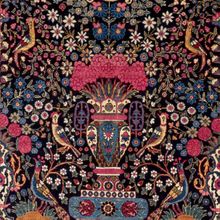Tehran Rug
| Tehran Rug | |
|---|---|
 Design of Tehran Rug (Rugman) | |
| General information | |
| Name | Tehran Rug |
| Original name | قالی تهران |
| Alternative name(s) | Tehran Carpet |
| Origin | |
| Category | City |
| Technical information | |
| Common designs | Medallion, Tree, Vase, Boteh |
| Common colors | Blue, Black, Ivory, Red, Yellow, Green |
| Dyeing method | Natural, Synthetic |
| Pile material | Wool |
| Foundation material | Cotton |
| Knot type | Symmetrical (Turkish), Asymmetrical (Persian) |
Tehran carpet or Tehran rug is a city rug that is woven in Tehran, the capital of Iran and located in the north central region of the country. These rugs are employed symmetrical and asymmetrical knots with cotton foundation and a wool pile. The designs of these rugs are Medallion, Tree, Vase and Boteh, and the colors are Blue, Black, Ivory, Red, Yellow, Green.
History
Tehran is the capital of Iran, located in the north central region of the country. It became the official capital of Persia under the Qajar Dynasty in 1795. Tehran carpets from the turn of the twentieth century, which were produced on a limited scale, are known in the antique carpet market.
Tehran rugs and carpets have design influences from Isfahan and Kashan, dating from the Safavid Carpets classical period. The carpets are floral, in allover, medallion, or directional Mihrab (prayer arch) styles. Shah Abbas palmettes with leaves and vines, Minakhani (rosette-linked trellis), Millefleurs, Shrub motifs, wild animals, birds, or floral bouquets were delicately executed in the field, borders, and spandrels. The Lattice pattern also was a popular allover style in Tehran weavings.
Tehran carpets have a cotton foundation and a wool pile. In rare instances, silk was employed for design highlights. The Persian (asymmetric) knot is used. The beautiful Tehran carpet tonality is particularly apparent in their red, light blue, and gold fields. In addition to these colors, dark blue, ivory, green, coral, and brown are used in the design motifs and outlines, borders, and, occasionally, in the background. The sizes found in the market range from approximately five feet by three feet to twenty feet by fourteen feet, and the rugs are woven in grade qualities of very good to fine.
During the 1940s the production of Tehran carpets was discontinued. After World War II, however, the city of Varamin, located near the capital, began to produce similar carpets that were marketed as Tehran carpets.
Tehran markets have the largest inventory representing carpets and rugs from all over Iran. Hundreds of new and antique rug dealers work tirelessly to bring merchandise of all styles and qualities to Tehran for the wholesale trade. In addition, many carpet galleries throughout the city service the domestic market. After World War II, Tehran wholesalers from all ethnic backgrounds, as well as Muslims, Jews, Armenian Christians, and others, contributed substantially to the worldwide foreign export of Iranian rugs and carpets. Some famous exporters were Avakian Brothers, Banilevy Brothers, Bolour Brothers, Bonakdarian Company, Etessami Brothers, Houshiar Company, Jahda Brothers, Karmely Brothers, Levian Brothers, Momeni Brothers, Roubeni Brothers, Shahkery Brothers, Yacoubi Brothers, and Yamin Brothers, all of whom greatly contributed to the successful introduction of Iranian carpets to the Western markets.[1]
See also
| Search for Tehran Rug on Wikipedia. |
References
- ↑ Moheban, 2015, 568-570
Bibliography
- Abraham Levi Moheban. 2015. The Encyclopedia of Antique Carpets: Twenty-Five Centuries of Weaving. NewYork: Princeton Architectural Press.